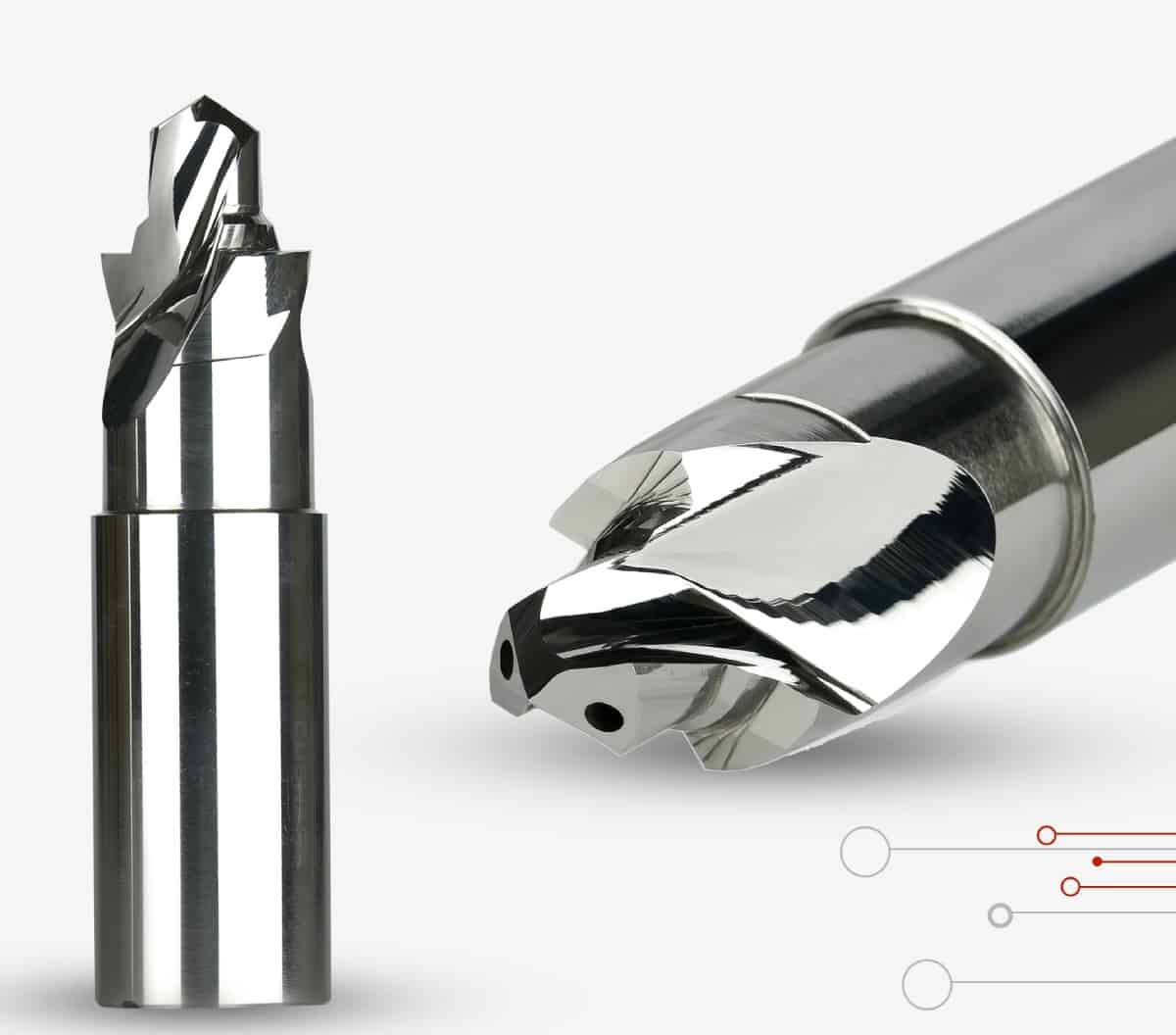Thread mills are milling tools that are used to cut threads. Thread mills are utilised on CNC machining centres with simultaneous triaxle control and helical interpolation features. Thread milling is more stable than general tapping, with less cutting condition limits in terms of chip management and coolant lubricity.
A Thread mill is just an end mill with the thread profile on the side. You can helically interpolate the Thread profile onto a work piece by using multiple axes of a CNC machine.
Because the mill must be able to enter the drilled hole and interpolate, unlike a tap, a Thread mill has a smaller diameter than the thread size being produced. Thread milling tool gives superior control Because the thread’s major diameter changed using the machine’s cutter compensation.
Threads and Thread Mills: What You Need to Know
Thread milling can be difficult for machinists. While thread mills are capable of manufacturing Threadwith relative ease, machinists must make a number of decisions before starting the process to
Ensure consistent output. Machinists must first learn basic thread milling applications in order to
Visualize these features and select the appropriate tool.
What exactly is a Thread?
A thread’s principal role is to create a connection between two separate mechanisms. Consider your water bottle’s cap. To make a watertight seal, the cap connects to the top of the Bottle. This coupling is capable of transmitting motion and assisting in the acquisition of mechanical benefits.
Terminology for Threads
- Thread from the Outside
Threads on the external surface of the mating component
- Thread from the Inside
The inside surface of the mated portion has threads.
- Largest Diameter
The internal or external thread with the greatest diameter.
- Minor Diameter
The internal or exterior thread with the smallest diameter.
- Diameter of the Pitch
An internal and external thread assembly’s dimensions are correlated using theoretical diameter
- Pitch
The distance measured between crests on a thread between like points on thread.
- Depth Of Thread
When measuring perpendicular to the thread’s axis, the distance from root to crest.
- Angle of the thread
Each thread’s angle from crest to root is included.
- Crest
On an internal or external thread, the surface area of each thread’s peak.
- Root
On either an internal or exterior thread, the surface area of each thread’s valley.
Thread Mill
When it comes to choosing the right Thread Mill , there are a lot of factors to consider, such as hole size, cutting parameters and cycle times, as well as the type of coating used, whether to use coolant through or flood coolant, and the tool design and size.
The thread mill to use is determined by a number of factors, including the item to be manufactured, the material’s hardness, and the thread dimensions required.

Advantages of Thread Mills Cutter:
- Right On size
The primary diameter of a thread can simply be changed using the machine’s cutter
Compensation to generate exact threads. Thread mills has a longer tool life than standard
Tapping because wear can be compensated.
- Multiple Diameters? No problem
A thread mill is just an end mill with a certain thread shape and pitch.
It is possible to programme the machine to helically interpolate to the desired diameter.
- No more broken taps!
It can be quite costly to save a work piece when taps break. If a thread mill breaks during a cut, a new one must be purchased. Can re-enter the pit and begin over with very little time wasted in the beginning .creating huge or expensive threads. There is no longer a chance of losing pieces. A presenter is a person who sets the tone for the rest of the recommended for tool height precision.
- Left and Right handed Thread
There are no left-hand or right-hand thread mills. To construct the Thread’s helix, the thread mill must travel up or down one pitch in the z axis while interpolating. The thread mill will just make grooves inside the hole if the z axis is not moving. There is no need to request a left-handed tap any longer. A single thread mill can handle a variety of tasks.
- Internal and external Threads
Threads, unlike tapping, can be machined on the inside or outside of the material; however, not all thread forms have the same features for their internal and external mating surfaces.
Some threads may necessitate the use of an internal or external thread mill.
Thread Milling
When working with difficult-to-machine materials like titanium, tool steels, stainless steels, toughened steels, and other super alloys, thread milling, a fundamental metalworking procedure for creating threads, is often the operation of choice.
Thread milling has long been utilized in the energy and automotive industries, but it is now gaining traction in the aerospace and medical fields. It’s most commonly employed on large aerospace work pieces and small medical work pieces.
Thread milling is one of the final operations in the machining process, and it normally produces an internal thread, however it can also produce external threads.
Unlike thread milling, which uses interrupted cutting, tapping uses a continuous cut process, making thread mills effective in exotic materials ranging from soft to hard. For these types of applications and parts, thread milling is a viable option.”
Despite the fact that thread milling is usually a safe solution for threading difficult-to-machine materials, tools do fail, but the work piece is not destroyed. “If a Thread mill breaks during a threading process, the diameter of the actual tool is smaller than the hole, making it easier to fish the tool out of the hole,”
Despite the fact that Thread milling is a well established procedure, some machine companies are still hesitant to use it because they believe it is too difficult. Although thread milling is not difficult, some shops are unwilling to undertake it.
Thread milling necessitates a machining centre that can do helical interpolation, which necessitates simultaneous movement of three axes.
Circular interpolation is performed by two axes, while the third travels perpendicular to the circular plane. This feature is available on most CNC machines developed in the last 10 to 15 years.
Thread milling is similar to any other method of material removal. Multiple machining passes may be necessary depending
on the amount of material to be removed and the material’s machinabilit.
The more material, the coarser the pitch. That must be removed.
Considerations for Thread Milling
Thread milling is the process of using a thread mill to generate a desired thread form on a workpiece by interpolating it around or inside it.
Chip control is improved by machining many radial passes.
Thread milling, on the other hand, must be done on machines that can move on the X, Y, and Z axes at the same time.
5 Pointers for successful thread Milling Operation.
- Choose a Quality Cutting Tool Manufacturer.
The importance of proper tooling cannot be overstated. Choose a reputable manufacturer of High Performance Drills for your starter holes and thread milling solutions to minimise tool failure and machining errors. Treadmills, including Single Form, Tri-Form, and Multi-Form Thread Milling Cutters, are all available from Accusharp Cutting Tools.
- Choose the Right cutter Diameter.
Only use a cutter with a diameter as large as you require. Threads of superior quality can be
Achieved with a smaller cutter diameter.
- Make sure you are at ease with your tool path.
Left or right hand threads will be determined by the tool route you choose.
Climb milling is performed by moving cutters counterclockwise in an ascending motion during
Right-hand internal thread milling.
Left-hand internal thread milling ensures that climb milling is performed by following a left-hand thread in the opposite way, from top to bottom, also in a counterclockwise pattern.
- Determine the number of radial passes required.
To attain the desired quality in tough applications, several passes may be required.
Separating the thread milling procedure into numerous radial passes results in a finer thread
Quality and increases tool security in tough materials. Thread milling with many radial passes
Also improves thread tolerance since tool deflection is reduced.
- Examine the Chip Evacuation Plan.
Are you taking the appropriate precautions to avoid chip recutting as a result of poor chip
Evacuation? If you don’t, your thread may become intolerant. Choose a plan that involves tool retractions, coolant, and lubrication.
Thread Milling Operation Benefits:
- Produce threads that are perfect in terms of form, polish, and dimension correctness.
- Machining of tough materials is simple.
- One tool for blind or through holes
- Remove the possibility of tap breakage and its repercussions.
- Positional precision at its best
- Full-bottom threading and exact thread depth control are possible.
- CNC offset can be used to regulate pitch diameter.
- Right-hand and left-hand threads can both be threaded with the same tool.
- Produces small, manageable chips
Applications Industry
- Automotive Industry
- Machine tools Industry
- Medical equipment Industry
- Aerospace
- Energy
Accusharp Cutting Tools Manufacturers provide a variety of solutions that are suited to your individual requirements, but its Accusharp Cutting Tools service that really sets them apart from the competition. On request, Accusharp Cutting Tools support professionals will create the appropriate tool selections and then provide you with the necessary machine codes to ensure that the tooling runs as efficiently as possible.
Thread milling has a number of advantages that might help you save money and enhance your
Productivity. Accusharp Cutting Tools provide a range of services that range from good to better to Best.
Contact us for additional information or to inquire about purchasing thread milling Tools for your operation.


